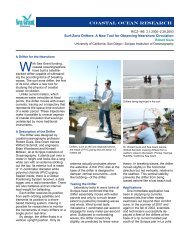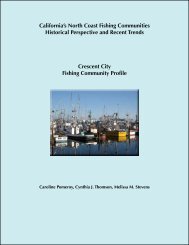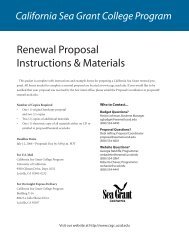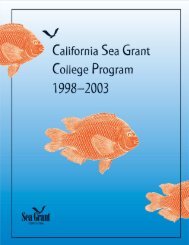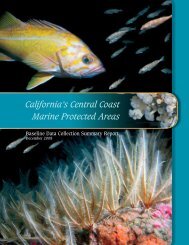2001â2002 - California Sea Grant - UC San Diego
2001â2002 - California Sea Grant - UC San Diego
2001â2002 - California Sea Grant - UC San Diego
Create successful ePaper yourself
Turn your PDF publications into a flip-book with our unique Google optimized e-Paper software.
The goal is to understand what kinds of habitats—such as rock reef, kelp<br />
forest, eel grass or sand and boulder—newly settled fish utilize and for how<br />
long. Sampling will be conducted monthly at nine sites, and all sites will be<br />
sampled within a two-week window to capture “pulses” of rockfish settlement.<br />
The sites that will be monitored in <strong>California</strong> are Morro Bay,<br />
Monterey Bay, Bodega Bay, Humboldt Bay, Fort Bragg and Crescent City.<br />
The Oregon sites are Port Orford, Coos Bay and Newport.<br />
The project is a collaborative effort led by <strong>California</strong> <strong>Sea</strong> <strong>Grant</strong> Extension,<br />
with scientists from Oregon <strong>Sea</strong> <strong>Grant</strong>, the National Marine Fisheries<br />
Service (NMFS), the <strong>California</strong> Department of Fish and Game (CDFG), the<br />
South Slough Estuarine Research Reserve, the Oregon Department of Fish<br />
and Wildlife, and the Pacific Marine Conservation Council. Both CDFG<br />
and NMFS are in the process of developing fishery management plans for<br />
rockfish species. McBride’s project complements an ongoing CDFG survey<br />
of adult rockfish populations.<br />
There are more than 60 species of rockfish off the U.S. West Coast.<br />
Within the last decade, many of these stocks have plummeted to catastrophically<br />
low levels, to the point that huge swaths of the shelf have been<br />
closed to groundfish fishing. McBride said that some of these deep-water<br />
species may use shallow water habitats during their early life stages,<br />
migrating to deeper waters as they get older. The project may be able to<br />
confirm whether this is true and for what species.<br />
McBride is also hoping to work with fishermen to establish “index<br />
sites,” which could be monitored as proxy estimates of young rockfish<br />
abundance in the surrounding areas.<br />
BALLAST WATER PROJECT ENTERS<br />
FOURTH YEAR<br />
Ballast water discharged from ships has been<br />
identified as a primary means by which non-native<br />
plants and animals are transported around the<br />
globe and introduced into foreign coastal waters.<br />
Most of these species die, but some of them not<br />
only survive but thrive in their new habitats, often<br />
displacing native species and altering native<br />
habitats. This problem has caused millions of<br />
dollars in economic and environmental damage<br />
<strong>San</strong> Francisco Bay Counties<br />
JODI CASSELL<br />
<strong>Sea</strong> <strong>Grant</strong> Extension Program<br />
300 Piedmont Avenue<br />
Bldg. B, Room 227<br />
<strong>San</strong> Bruno, <strong>California</strong> 94066<br />
jlcassell@ucdavis.edu<br />
Phone: (650) 871-7559<br />
Fax: (650) 871-7399<br />
http://ballast-outreach-ucsgep.ucdavis.edu<br />
Photo: Michael Nevins, U.S. Army Corps of Engineers<br />
33



